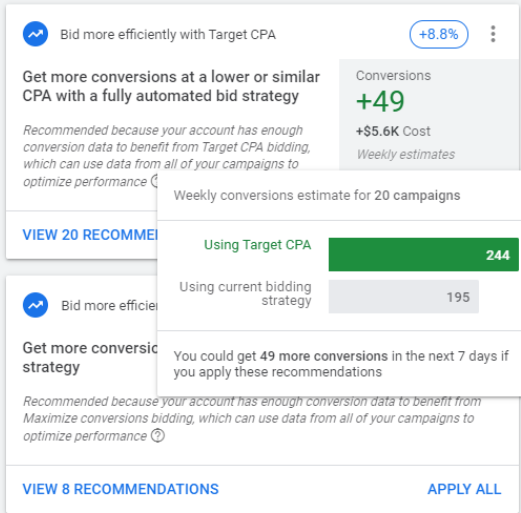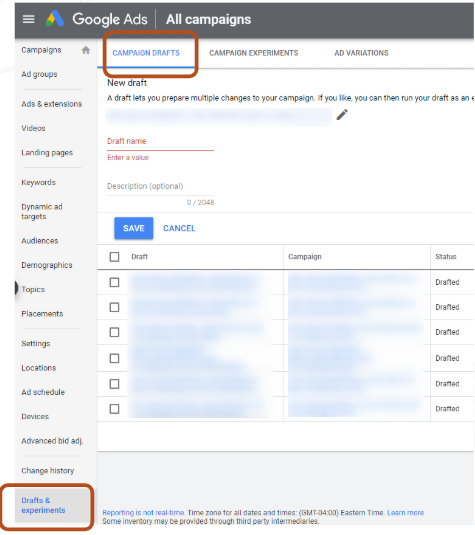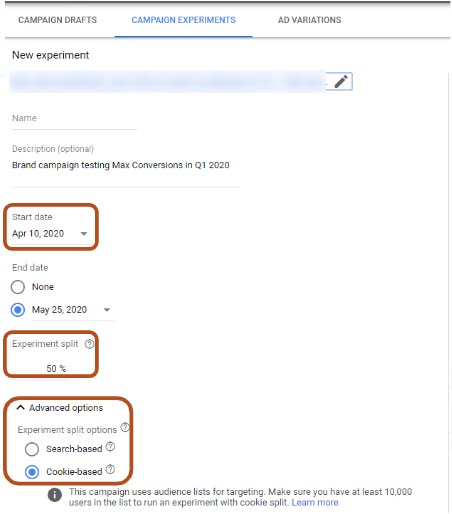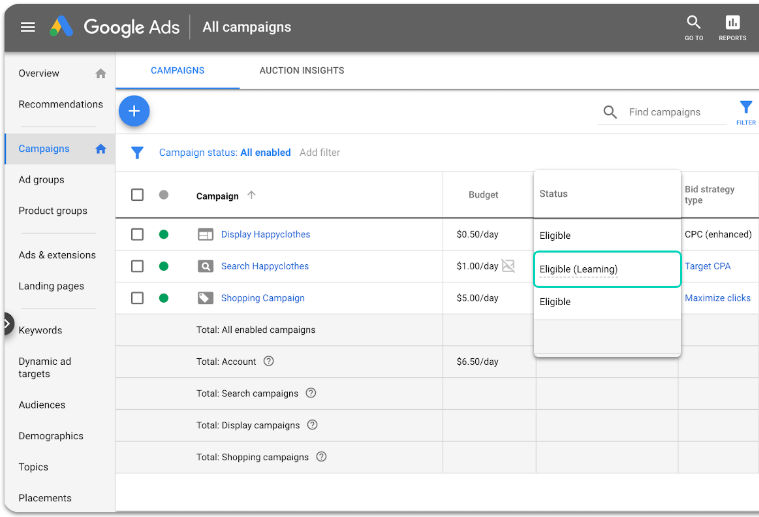Sometimes a shove is the best way to get into the pool.
If you approach a pool by taking the ladder and dipping just a foot in, the difference in temperature between the pool and the body is going to be shocking and unpleasant. You’re more likely to turn back to dry land and fry in the sun. But if a “funny uncle” just grabs you and throws you in, the shock is over in a second, and you realize just how nice it is to be embraced by the water.
I intend to be that funny uncle for you.
Below, I’m going to shove you into the water a bit. We’ve already covered the biggest objections to smart bidding. So this time, we’ll go over how to test smart bidding in a way that will make it easier to jump right in, and how to evaluate your testing to feel confident in the results you see.
Identify which campaigns to test and which strategy to use
When deciding which smart bidding strategy to use, there are a few options for you.
The first is the most straightforward -- check out the Recommendations tab. Both Google and Microsoft have introduced “Recommendations” tabs, which will clearly identify campaigns that are likely to benefit from a smart bidding strategy.
 The Recommendations Tab will show you which campaigns the engine thinks will thrive with a smart bidding strategy.
The Recommendations Tab will show you which campaigns the engine thinks will thrive with a smart bidding strategy.
But it’s not entirely necessary to wait for one of those recommendations to show up in the tab. It’s pretty easy to identify which strategy you may want to use, just by asking yourself a few simple questions about your campaigns. These questions are easily encapsulated in a handy flowchart:
 Don’t overlook conversion tracking! Make sure you’re tracking the things that are important & that it’s tracking accurately.
Don’t overlook conversion tracking! Make sure you’re tracking the things that are important & that it’s tracking accurately.
The good news here is that it’s hard to go wrong with your smart bidding strategy. According to Google, fully-automated bidding solutions drive between 30%-35% more conversions, compared to a semi-automated bidding strategy like eCPC, which can only hope to drive a 7% increase. Once you know what you want to test, let’s figure out the best testing methodology.
High Risk Tolerance = Dive into the deep end of the pool
If you or your client has an appetite for risk, take the opportunity to fully switch your campaign(s) over to smart bidding without an A/B testing period. I know it’s scary, but it’ll be the fastest way to see results for your new bid strategy. You’ll still want to evaluate the performance after switching, and we’ll get to that (see evaluation section below), but don’t waste performance potential by splitting your traffic with a typically-inferior bidding method.
Lower Risk Tolerance = Hop into the shallow end of the pool
If you or your client is a little more risk-averse, then an A/B test using Drafts & Experiments is going to be your best friend. Let’s set one up, shall we?
- Click into the “Drafts & Experiments” screen from the left-hand menu.
- From the Drafts tab, click the big blue button, and choose the campaign you wish to test your new bid strategy.
- Name the draft in some way that you can easily identify and take an extra few seconds to type in a description so there’s no question what this draft is for.
 Navigating the Campaign Drafts interface
Navigating the Campaign Drafts interface
Now, click over to the Experiments tab and find that blue button again. Here we’ll be setting up the experiment parameters.
- Name your experiment whatever you wish, but be aware that THIS is what the campaign will look like in the engine interface, Editor, GA, and your CRM. So make sure it conforms to any naming conventions you may use & is easy to differentiate from the original campaign.
- Set a specific start date. I usually set it for “Tomorrow” at the earliest, so that there is no mid-day overlap to account for or if I want multiple experiments to start simultaneously.
- You have the option for an end date if you need it, but Google recommends leaving it open-ended so if you need it to run longer than planned, you don’t have to worry about it ending prematurely. If you need to set an end date, make sure it’s at least 4 weeks out from launch.
- In most cases, you’re going to want to set your split to 50%. This ensures the most even test. However, for sensitive campaigns or very skeptical clients, you may want to adjust this to be lower & let your test run longer.
- Finally, select how you want to split your audience. I prefer to use the Cookie-based split, that way each user gets a consistent experience. This ensures the most accurate testing. But read the info pop-ups to make sure you pick the option that’s best for you.
 Navigating the Campaign Experiments interface
Navigating the Campaign Experiments interface
The last major step for setting up an experiment is to tweak the setting you want to test. Make sure you don’t skip this step, or else you won’t actually be testing anything. If we’re only talking about a handful of campaigns, the easiest way to do this is from the Experiments tab again.
- Click on the Draft name shown in the Draft column of the Experiments tab
- Navigate to the draft’s Settings, scroll to Bidding, and change the bid strategy to whichever one you want to test
- Be sure to SAVE the change
 Be sure to click into your draft and adjust the setting you wish to test!
Be sure to click into your draft and adjust the setting you wish to test!
Note: if you’re rolling changes out to many experiment drafts at the same time, you can do so through Editor. Just download new changes from the web to import your new experiments. Be sure to change the setting on the campaign that shares the experiment name (see Step 4, above).
Evaluating your smart bidding tests
While you should definitely keep an eye on your campaigns throughout the testing period, after your tests have been running for at least four weeks, it’s officially time to evaluate.
Whether you dove into the deep end or took the drafts & experiments route, there are two important time periods you need to respect in order to properly evaluate the performance of the new bid strategies.
First is the Learning Period. Expect there to be a lot of fluctuation in the first 2 weeks, while the algorithms learn your audience’s signals. You’ll know you’re in a learning period if your status column says “Eligible (Learning)”. You can click into your Bid Strategy Report to discover how long the learning period is likely to last. Be aware: actions like drastically changing budgets, modifying your conversion settings, or sweeping changes to campaigns structure can all lengthen or trigger a new learning period. Try to avoid these actions while conducting a bid strategy test.
 Make sure you’re aware of when your campaigns are going through a learning period.
Make sure you’re aware of when your campaigns are going through a learning period.
Second is the Conversion Lag Period. Check out your attribution report to discover how many days on average it takes from first click to conversion. Be sure to use a 30-day lookback for search campaigns and a 90-day lookback for display.
Once you’re aware of these two periods, exclude those dates from your evaluation window. For instance, if you ran a 6-week test that had a 2-week learning period, and a 1-week conversion lag period, you’ll want to restrict your analysis to weeks 3-5.
 Make sure you exclude the Learning & Conv Lag periods when evaluating the performance of your smart bidding strategy.
Make sure you exclude the Learning & Conv Lag periods when evaluating the performance of your smart bidding strategy.
Use your Bid Strategy Report or the Experiments screen to evaluate performance during the Evaluation Period. Then there’s just one more decision to make.
Win, lose, or draw, don’t stop smart bidding
This may be a tad controversial, but whatever the outcome of your smart bidding test, you should keep using the smart bidding strategies available to you. Have a definitive, statistically significant winner? Great! Keep it going. Have results that aren’t statistically significant? That’s okay -- if smart bidding and manually bidding are so neck-and-neck in performance that there’s no clear winner, it’s in your best interest to let the smart bidding algorithms keep doing their thing and turn your attention to other matters.
But what about a definitive fail? Well, if that happens, you need to re-evaluate your testing parameters -- did you pick the best strategy for your campaign? Is the campaign structured the best it could be? How’s the ad copy relevance? The landing page experience? Were there outside factors that may have impacted things? Did you talk with your reps to see what they have to say? All a failed test means is that you have more testing to do.
Overall, smart bidding is a tool you need to be using. This digital marketer is counting down the days until smart bidding is the only option available. So, come on in; the water is great. Let us know what you think about this guide and what methods you’ve used to try out smart bidding in the past.


